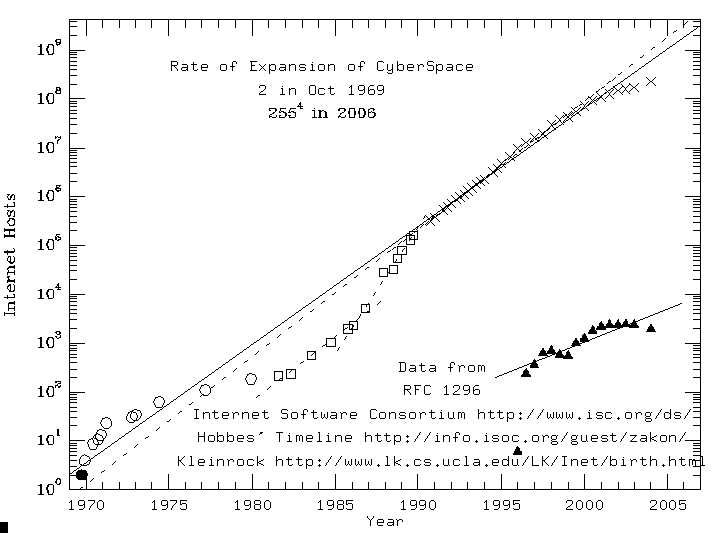Expansion of CyberSpace


If you include the actual origin of networking in October 1969 as described by the founder of the ARPA net Len Kleinrock you derive the rate of expansion as 14.2 months.
Interestingly the rate of expansion of the US Internet between 1980 and 1987 was 13.7 months very similar to the current growth. IMHO the gradual inclusion of about 70K hosts from International and other US networks in the Internet hosts table and the removal of a US-centric selection bias, could explain the apparent inflation in the late 80's. Currently about 40% of the hosts are International, and 70K is about that fraction of the total hosts sometime in 1989, which is also the end of the apparent inflation.
I concluded in 1998 that the average rate of exponential growth of the Internet hosts was almost a constant and it remained so for the next 2-years. There seems to be a clear slow-down of growth in the most recent years, reflecting probably what has been happening recently to the dot-com industry. The number of hosts grew by only 34.5% 16.5% and 35.8% in 2001, 2002 and 2003 very much less than the average 85% per year seen over the decade from 1990 to 2000.
Please read current description of Survey. Although it is called Domain Survey, Since Jan 1998 it counts IP-hosts which respond to query. Note however that many static IP-hosts are not always connected to the Internet and may computers that connect to the Internet share temporary dynamic IP numbers. Domain names are also unreliable since many have been purchased for cybersquatting by persons hoping to sell them for a profit. Also note that graph above is a estimate of hosts on the Internet not CyberInfo posted on the web. The latter is probably growing at a different exponential rate linked to the fast decrease of price of Disk Storage space and connection Band-width. Although the absolute numbers may be questioned, the rate of growth is probably a good measure of the rate of growth of CyberSpace.
For History of Internet follow links in the Telson Spur. A new address system IPV6 (128 bit) is being adopted long before "Saturation" of the current IPV4 4 x 8 bit based address system. No longer does the number of hosts reaches 255**4 in 2006.
More recently, many years after first making the above graph I found the number of hosts between 1969 and 1979 from Hobbes' Internet Timeline referenced in the Book NERDS 2.0.1 - A Brief History of the Internet by Stephen Segaller (1999 Oregon Public Broadcasting) and have included those points in the above graph.
See interesting graph comparing growth in U.S. Market Technology trends in Radio, TV, and Cable with the Internet.
The filled triangles on the lower right is the growth of hosts in domain .lk The rate of expansion is 19.5 months for the .lk hosts in Sri Lanka to double is size before 2000. Many of the computer hosts in Sri Lanka however are not in .lk domain. However it is unlikely to make so much difference in my conclusion that Sri Lanka is still starved of computers. Sri Lanka with a population of 18 million has 3000 per million persons living in the world. However the .lk domain has only 14 per million computer hosts in the world in 2003 January. It grew by only 2% in 2002 very low even in comparison to the slowed global growth of hosts of 16.5%.
This document was first posted over 5 years ago in 1997 February.
A few older archived versions of the text can be
read
on the Wayback Machine which is a 120 TeraByte archive of the Internet
from 1996-2001. It posts archived pages more than 6-months old,
and has saved a limited number of images from only the higher-level webpages.
The Wayback Machine is also great to lookup old predictions like Doomsday in 1996 (23 October 4004 BC + 6000 years) which became 1997 and is now 2033 :-)
kavan@makara.phys.cmu.edu Last updated: 2004 Feb 11th